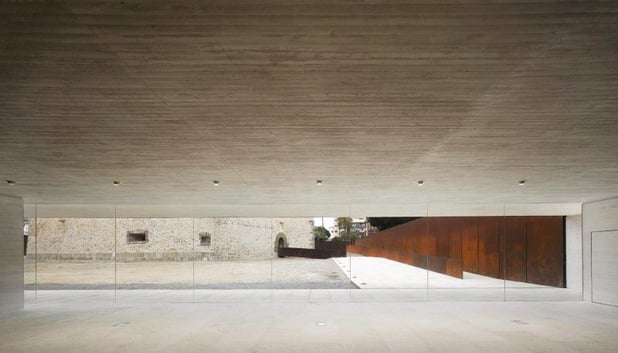Un edificio histórico
En plena conquista de las Islas Canarias por el Reino de Castilla la piratería amenazaba a los barcos que volvían de América cargados hasta los topes y con las tripulaciones agotadas. El capitán Juan Rejón ordena construir un fuerte de madera en 1478 sobre un arrecife, que el Atlántico aislaba en la pleamar, para proteger a las expediciones de regreso. En 1494 el tercer gobernador de las Islas Canarias, nombrado por Castilla, ordenó construir sobre aquel fuerte en aquella lengua de rocas, el recio y poderoso Castillo de La Luz, sustituyendo la debilísima estructura de madera por gruesos muros de piedra y mortero que soportarían el embate del mar. Con lo que no pudo la fortaleza fue con el avance implacable de la ciudad sobre aquella peninsulita y el vacío entremuros se rellenó de arena. Se había quedado sin luz…cegado…el Castillo de la Luz.
La rehabilitación del edificio
Por ello la operación más importante de la rehabilitación del edificio histórico ha consistido en introducir la luz en el Castillo de la Luz, vaciando los fosos de arena invasora, y revelando la asombrosa e irregular mampostería, perforada por vanos de originales formas y graciosísima disposición. Intramuros se han dispuesto superficies claras que contrastan con la irregular sillería y con las barandillas hechas de hojas de acero cortén. Las nuevas superficies acentúan la belleza de las viejas y acogen la nueva luz que les llega rebotándola para homenajear a esta arquitectura militar y marítima.
Nieto y Sobejano ( ambos nacidos en Madrid en 1957) son los componentes del espléndido estudio de arquitectura que ha devuelto la vista al castillo con esta magistral rehabilitación. Es una tarea ingente recordar los éxitos de esta pareja de arquitectos de la escuela de Madrid. Evocaremos, por tanto, su último e importantísimo triunfo en el concurso para construir el futuro Museo de la Ciencia de Guangzhou. Se trata de una serie de enormes volúmenes inspirados en los tazones de cerámica china tanto en su forma como en la superficie cerámica. Una vez más Nieto y Sobejano se inspiran en una idea genial y autóctona para expresar su finísima sensibilidad.

Pero volvamos a lo que nos ocupa… nuestro castillo. Como el proyecto de rehabilitación incluye, también, un cambio de uso (de militar pasa a ser museístico) la rehabilitación aprovecha el volúmen despejado frente a la ciudad para levantar el necesario pabellón de acceso. En otro destello de finezza y técnica por parte de Nieto y Sobejano este edificio complementario se contrapone al castillo por contraste, al optar por la dimensión horizontal. Una gran losa de acero cortén se macla con otra de hormigón blanco y un sutilísimo lucernario de vidrio traslúcido. Aparecen además, perforaciones que confirman esta vocación por intoducir luz solar en todos los rincones.
Todo el recinto está delimitado por un muro de acero cortén en planchas de 2,30 x 1,70 separadas por 5 cms. lo que aumenta el misterio del que pasea alrededor y la sorpresa del que entra. Estos muros, de escasísimo espesor, casi como hojas de cartón, acompañan al deambular perimetral de acceso y salida y vuelven a contrastar con los potentísimos muros de piedra del rehabilitado Castillo de la Luz. La masa protagonista, presenta añadidos de acero cortén que forman lucernarios y una terraza que proporciona una vista entre las almenas, de la ciudad y del patio de la construcción militar, donde los hermosísimos Tilos plantados en una arena, color albero, vuelven a contrastar sus tonos verdes con los tonos rojizos del acero corté y el blanco del hormigón.
En el antiguo foso, ahora jardín de tupido césped, ha colocado una extraordinaria y emblématica pieza de forja el renombrado y admiradísimo escultor canario, Martín Chirino (1925, Las Palmas de Gran Canaria) que trabaja con la Galería Marlborough de Madrid desde hace muchísimos años. Esta obra (seguramente forjada en el taller que el artista posee en Chinchón, Madrid), conversa en fluido diálogo con el Castillo de la Luz, ahora por fin iluminado e iluminador del Atlántico.
En Antana mantenemos una sensibilidad muy especial en la rehabilitación de edificios históricos, siendo conscientes de la importancia de los detalles constructivos en este tipo de obras.